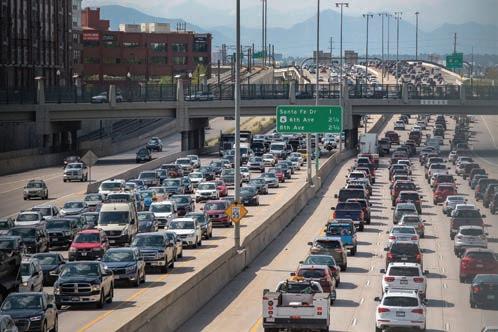
7 minute read
MEDICAID CLIFF SURVIVING THE
of the curve,” he said.
Local government leaders have been wary of the proposals, previewed in the governor’s State of the State address in January, because of how it would restrict their power to create and enforce housing policies.
“Respectfully, get o our lawn,” Kevin Bommer, executive director of the Colorado Municipal League, said at a gathering of local o cials in February when describing negotiations on the legislation with Polis’ o ce.
e organization’s board voted to oppose the land-use bill last week, Bommer said. “CML opposes this sweeping and breathtaking attempt to centralize local land use and zoning policy in the state Capitol, while doing nothing to guarantee a ordability,” Bommer said in a written statement, also calling the measure a “breathtaking power grab.” e only Colorado mayor who spoke in support of the bill at a Capitol news conference on March 22 rolling out the legislation was Boulder Mayor Aaron Brockett. “ ere’s still some work to be done and I’m sure there’ll be changes hashed out,” he said. “But there is so much at value here.” e bills are also expected to meet erce pushback from the few Republicans in the legislature, who are in the minority in the House and Senate and have little say over which measures pass or fail. e measures have been the talk of the Capitol since the 2023 legislative session began in January, but the details of what’s in the legislation have been under wraps until now. Democrats will have less than two months to pass the bills through the House and Senate before the lawmaking term ends in early May. e governor’s o ce says the landuse bill was drafted after more than 120 meetings with housing and business experts and local o cials and through research on similar policies passed in other states. Oregon, for instance, passed a law in 2019 requiring cities with a population greater than 1,000 to allow duplexes, while cities with more than 25,000 people must allow townhomes, duplexes, triplexes and fourplexes. e measure reshaping land use in Colorado would apply only to municipalities, not counties. e governor’s o ce and the bills’ sponsors believe they can impose policy restrictions on cities and towns because housing is an issue of statewide concern, a position that could be tested in court.
Rep. Steven Woodrow, a Denver Democrat who will be one of the prime sponsors of the land-use bill, said the measure is supposed to prevent some Colorado communities erecting barriers to development while their neighbors sprawl out of control, which can cause gentri cation and water issues.
“We have to do this at the state level because local political pressures are such that it hasn’t been hasn’t been done until now,” Woodrow said.
“Research has shown that increasing housing supply, like building units like duplexes and townhomes, can increase a ordability,” Senate Majority Leader Dominick Moreno, a Commerce City Democrat and a lead sponsor of the bill, said at a news conference as the bill was unveiled. “Yet these types of housing are often prohibited in many of the communities that need them the most. And that doesn’t make sense.”
An unanswered question is whether developers will take advantage of the bill, should it pass.
“I think that people are anxious to provide housing,” said J.J. Ament, president and CEO of the Denver Metro Chamber of Commerce, which supports the bill. “I don’t think it really is a capital problem in Colorado. It is regulatory and environment. I think the capital will ow because the demand is there.” e legislation is slated to be formally introduced this week. e measures were described in detail to e Sun by their sponsors and the governor. e requirements will vary for different parts of the state depending on which of ve categories they fall into based on their population and housing needs. Here’s how the requirements would break down:

Tier 1, with cities that include: Arvada, Aurora, Boulder, Brighton, Broom eld, Castle Pines, Castle Rock, Centennial, Cherry Hills Village, Columbine Valley, Commerce City, Denver, Edgewater, Englewood, Erie, Federal Heights, Glendale, Golden, Greenwood Village, Lafayette, Lakewood, Littleton, Lochbuie, Lone Tree, Longmont, Louisville, Northglenn, Parker, Sheridan, Superior, ornton, Westminster and Wheat Ridge.
Outside of the Denver metro area, Greeley, Fort Collins, Loveland, Windsor, Colorado Springs, Fountain, Grand Junction and Pueblo would also be considered Tier 1 cities.
Cities in this category have a population of at least 1,000 and are in a metropolitan planning organization — such as the Denver Regional Council of Governments — with a population greater than 1 million and in a Census Urbanized Area with a population greater than 75,000. Cities with a population greater than 25,000 and in a metropolitan planning organization with a population less than 1 million would also fall into this category.
Tier 1 cities would be most a ected by the land-use bill. ey would be prohibited from restricting duplexes, triplexes and multiplexes up to six units, as well as accessory-dwelling units, sometimes referred to as ADUs or granny ats. ey would also be prohibited from requiring parking tied to those kinds of housing.
ADUs are habitable structures that are on the same property as a house but a separate building, such as an apartment over a garage. Many municipalities across the state restrict where and how they can be built.
Tier 1 cities would also have to allow the construction of multifamily housing near transit centers, which are de ned as the half-mile area around xed-rail stations.Cities wouldn’t be allowed to require new, o -street parking for multifamily homes built in transit corridors, though developers could provide any amount of parking they feel is needed.
Tier 1 cities would also be subject to development guidelines aimed at promoting housing density and walkable communities around so-called key transit corridors, which are de ned as areas within a quarter mile of busrapid-transit and high-frequency bus routes.
Finally, Tier 1 cities will also be required to complete a housing needs plan based on a state housing needs assessment, as well as participate in long-term planning to stop sprawl and address environmental concerns, like greenhouse gas emissions, air pollu- tion and limited water. ey are de ned as cities in a metropolitan planning organization that have a population of between 5,000 and 25,000 and in a county with a population greater than 250,000.
Tier 1 cities have the option of meeting minimum land-use requirements set by the state, which the governor’s o ce refers to as the “ exible option.” If not, they would be forced to adopt a state-developed land-use code. e state code would be created by Colorado Department of Local A airs regulators at a later date.
Tier 1 cities would have to submit codes compliant with the bill to the state by December 2024. Any Tier 1 cities that don’t meet the minimum standards under the legislation’s so-called “ exible option” would be forced to operate under the model land-use code starting in December 2025.

Tier 2 is next, which includes Dacono, Fort Lupton, Firestone, Frederick, Evans, Berthoud, Johnstown, Timnath, Eaton, Miliken, Severance and Monument.

Tier 2 cities would be prohibited from restricting accessory-dwelling units and parking associated with ADUs, though they would be able to block duplexes, triplexes and multiplexes. ey would also be exempt from provisions around transit centers and corridors. ey would, however, still be required to conduct housing needs assessments and create the same type of long-term housing and sprawl and environmental plans.
Tier 2 cities would have to submit codes compliant with the bill to the state by December 2024. Any Tier 1 cities that don’t meet the minimum standards under the legislation’s so-called “ exible option” would be forced to operate under the model land-use code starting in December 2025. is category is intended to prompt local governments to work with their surrounding region to address housing shortfalls. e communities would be required to allow ADUs but then have to develop a regional housing needs plan to identify where zoning should happen for duplexes, triplexes and other multiplexes. e communities would also have to work together to boost transit corridors and housing surrounding them.
Another category is dubbed, Rural Resort Job Centers. is category includes Aspen, Avon, Breckenridge, Crested Butte, Dillon, Durango, Frisco, Glenwood Springs, Mountain Village, Silverthorne, Snowmass Village, Steamboat Springs, Telluride, Vail and Winter Park.



Rural resort job centers are de ned as municipalities that have a population of at least 1,000 and at least 1,200 jobs and are outside of a metropolitan planning organization. ey also have regional transit service with at least 20 trips per day.
“ ere’s often a dynamic in rural areas where people may live in one community but work in another, and because of that the additional exibility is that they can reach agreements with their partner communities to have a more regional approach to some of the goals that are in the bill,” Moreno said.
Like Tier 1 and Tier 2 cities, rural resort job centers would have the ability to choose between a minimum level of housing policies while maintaining some of their own design standards or be forced to adopt a model land-use code that will be created by the state. e speci cs on those two options are not laid out in the bill and would be determined later by state regulators. is story is from e Colorado Sun, a journalist-owned news outlet based in Denver and covering the state. For more, and to support e Colorado Sun, visit coloradosun.com. e Colorado Sun is a partner in the Colorado News Conservancy, owner of Colorado Community Media.
“ e goals aren’t as stringent as the (ones for) urban municipalities,” said Moreno.
Rural resort job centers would have to submit land-use codes compliant with the bill to the state by December 2026. Any rural resort job centers that don’t meet the minimum standards under the bill’s exible option would have to operate under the state’s model land-us code starting in June 2027.
Yet another category is called NonUrban Municipalities. Any municipality with a population greater than 5,000 falls into this category — as long as it’s not in another category — including Alamosa, Brush, Cañon City, Carbondale, Cortez, Craig, Eagle, Fort Morgan, Gunnison, La Junta, Lamar, Montrose, Ri e, Sterling, Trinidad and Wellington. Non-urban municipalities would be prohibited from restricting accessory-dwelling units but won’t have requirements around duplexes, triplexes and other multiplexes or transit-oriented development. ey also won’t need to prepare a housing needs plan.





